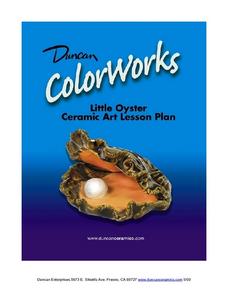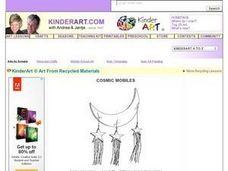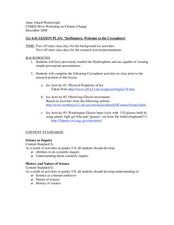American Museum of Natural History
The Amazing Mundo
Rocks and minerals are great on their own, but they also turn into some pretty amazing stuff! An online lesson explains the different types of materials we get from rocks and minerals, including glass, plastic, and coins. An embedded...
Curated OER
Why Invent That?
Students demonstrate an understanding of the text by completing an activity on the advantages and disadvantages of inventing and using a human-powered airplane.
Teach Engineering
Future Flights: Imagine Your Own Flying Machines!
What will flying look like in the future? The 21st lesson plan in a 22-part unit on aviation reviews the major aspects of the lesson plan. Pupils brainstorm ideas of a future flying machine.
PHET
Learning about Space Weather
Is the sun the only celestial body with magnetic fields? A guided discussion on the weather in space is designed with a mix of questions, discussions, explanations, and applications. Additionally, the resouce includes an article for...
Messenger Education
Give Me a Boost—How Gravity Assists Aid Space Exploration
The propellant needed for space explorations runs in the thousands, while paying to get the craft into orbit costs millions! In the second installment of three, two activities explore laws of conservation of energy and momentum. Using...
Cornell University
Alka-Seltzer Rockets
Blast off! An engaging hands-on activity has pupils create rockets powered by Alka-Seltzer. They learn about the physics behind these rockets throughout the process.
Curated OER
Aviation Pioneers
Students research the Wright Brothers historic first flight and design a travel poster asking for volunteers to participate. Write a newspaper account of the first flight and include how the local people may have felt about the Wright...
Curated OER
Gas Properities Definitions
Students, after reading the Web page Gas Properties Definitions, complete the activity to demonstrate an understanding of the properties of gases.
Curated OER
Wish You Were Here - Research Conditions on Mars
High schoolers research conditions on Mars, then create a travel brochure or presentation to attract tourists. They work in cooperative groups. Each member is assigned a different role and contribute specific information to the group's...
Curated OER
A Flag for Mars
Students investigate the historical use of flags on Earth, debate ownership issues for interplanetary exploration, and design a flag for Mars. The implication of placing a flag at a location forms the focus of the lesson.
Curated OER
Rotating Rings of Ice
Students work together to develop a model of Saturn and its rings. They identify what types of materials make up the rings and how they revolve around Saturn. They write a short paragraph describing the rings.
Curated OER
Going to Extremes
Students recognize that our ability to explore the extremes of the ocean is directly related to the technology of remote sensing. Students will recognize the deep submergence vehicle, Alvin, and the advanced sensors on board as tools for...
Curated OER
Gaining Familiarity with Magnetism
Students discuss their perceptions of magnetism and explore the background ideas of magnetism.
Curated OER
Weather Myths
Fourth graders relate myths to weather phenomenon. They write and illustrated a weather myth and present it to the class.
Curated OER
Weather Myths
Fourth graders examine myths that are based on weather phenomenon. They write, illustrate and present an original weather myth.
Curated OER
Aerology- The Study of Mars
Students investigate various aspects of the planet Mars. They examine a core sample that is simulated to make observations. Then compare the known sample with one that is unknown and differentiate between the two. Students hypothesize...
Curated OER
Ozone: The Earth's Security Blanket
Students work in groups to define and research the terms: ozone, troposphere and stratosphere. Students watch videos, conduct Internet research, participate in discussion groups and complete worksheets.
Curated OER
Little Oyster: Ceramic Lesson
Children will love researching and then creating a bottom dwelling mollusk of their own. They watch clips describing the ocean ecosystem and how oysters fit into their environment. Next, they research what oysters eat and how they look....
Curated OER
Life on the Moon
Students study the physical properties of the Moon. In this life on the moon lesson students describe the ways life on the Moon would be different than on Earth.
Curated OER
Lunar Real Estate
Students investigate the aspect of colonizing the moon by comparing techniques that are used on Earth. The colonization takes place with the planning of a hypothetical model. The model is used as a point of discussion and target...
Curated OER
Snow Goggles
Students assemble snow goggle models and discuss how snow goggles change the amount of light shining in their eyes.
Curated OER
Cosmic Mobiles: Recycled Art
If you have a little left over tinsel and aluminum foil, your class can create these fun moon and star mobiles. Poster board or recycled cardboard become your moon and stars; the tinsel gives them sparkle. This would be a great activity...
Curated OER
Explosive Ideas: Oregon quarter reverse
Explore Earth and her amazing layers with this lesson on planetary change. Students will research the ways in which Earth's layers cause change. They will complete a "Tectonic Puzzle" and use a worksheet to answer questions about Earth's...
Curated OER
IceHunters: Welcome to the Cryosphere!
Students complete an online exploration mission assigned by their teacher. In this ecology instructional activity, students write a newspaper article about their polar mission following certain criteria. They create a PowerPoint...

























